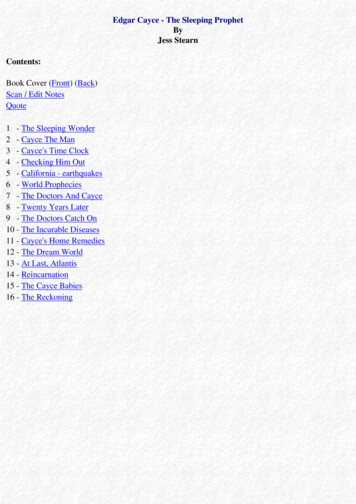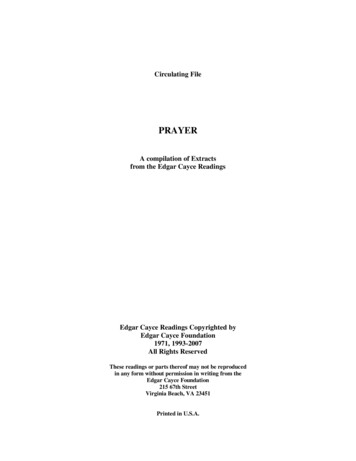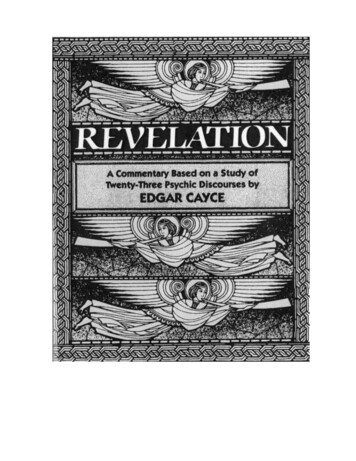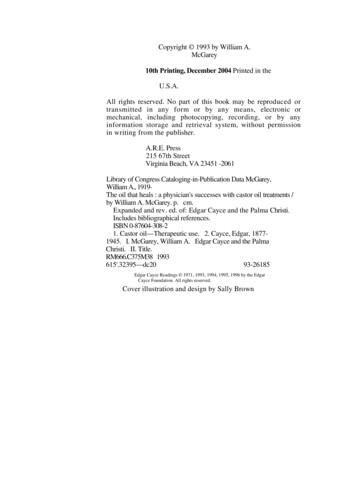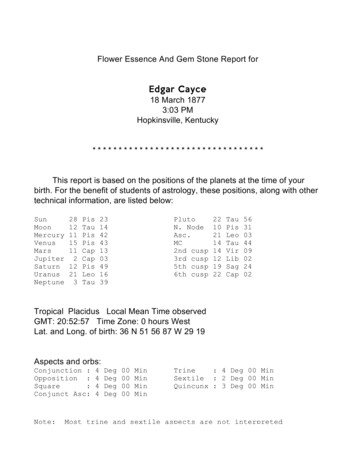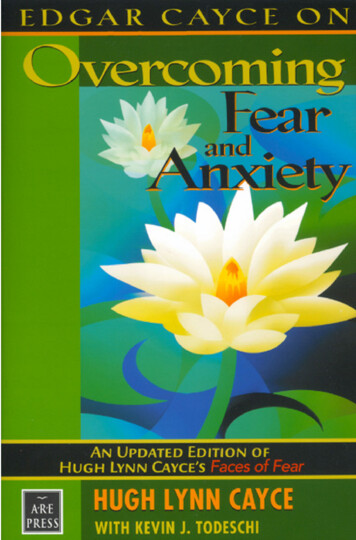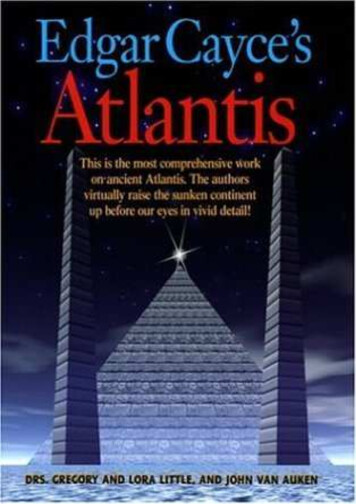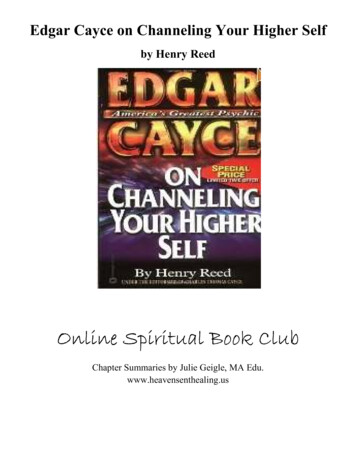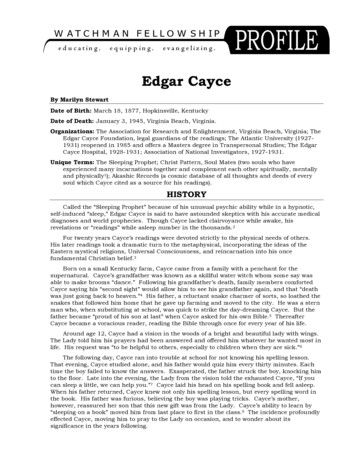
Transcription
Edgar CayceBy Marilyn StewartDate of Birth: March 18, 1877, Hopkinsville, KentuckyDate of Death: January 3, 1945, Virginia Beach, Virginia.Organizations: The Association for Research and Enlightenment, Virginia Beach, Virginia; TheEdgar Cayce Foundation, legal guardians of the readings; The Atlantic University (19271931) reopened in 1985 and offers a Masters degree in Transpersonal Studies; The EdgarCayce Hospital, 1928-1931; Association of National Investigators, 1927-1931.Unique Terms: The Sleeping Prophet; Christ Pattern, Soul Mates (two souls who haveexperienced many incarnations together and complement each other spiritually, mentallyand physically1); Akashic Records (a cosmic database of all thoughts and deeds of everysoul which Cayce cited as a source for his readings).HISTORYCalled the “Sleeping Prophet” because of his unusual psychic ability while in a hypnotic,self-induced “sleep,” Edgar Cayce is said to have astounded skeptics with his accurate medicaldiagnoses and world prophecies. Though Cayce lacked clairvoyance while awake, hisrevelations or “readings” while asleep number in the thousands.2For twenty years Cayce’s readings were devoted strictly to the physical needs of others.His later readings took a dramatic turn to the metaphysical, incorporating the ideas of theEastern mystical religions, Universal Consciousness, and reincarnation into his oncefundamental Christian belief.3Born on a small Kentucky farm, Cayce came from a family with a penchant for thesupernatural. Cayce’s grandfather was known as a skillful water witch whom some say wasable to make brooms “dance.” Following his grandfather’s death, family members comfortedCayce saying his “second sight” would allow him to see his grandfather again, and that “deathwas just going back to heaven.”4 His father, a reluctant snake charmer of sorts, so loathed thesnakes that followed him home that he gave up farming and moved to the city. He was a sternman who, when substituting at school, was quick to strike the day-dreaming Cayce. But thefather became “proud of his son at last” when Cayce asked for his own Bible.5 ThereafterCayce became a voracious reader, reading the Bible through once for every year of his life.Around age 12, Cayce had a vision in the woods of a bright and beautiful lady with wings.The Lady told him his prayers had been answered and offered him whatever he wanted most inlife. His request was “to be helpful to others, especially to children when they are sick.”6The following day, Cayce ran into trouble at school for not knowing his spelling lesson.That evening, Cayce studied alone, and his father would quiz him every thirty minutes. Eachtime the boy failed to know the answers. Exasperated, the father struck the boy, knocking himto the floor. Late into the evening, the Lady from the vision told the exhausted Cayce, “If youcan sleep a little, we can help you.”7 Cayce laid his head on his spelling book and fell asleep.When his father returned, Cayce knew not only his spelling lesson, but every spelling word inthe book. His father was furious, believing the boy was playing tricks. Cayce’s mother,however, reassured her son that this new gift was from the Lady. Cayce’s ability to learn by“sleeping on a book” moved him from last place to first in the class.8 The incidence profoundlyeffected Cayce, moving him to pray to the Lady on occasion, and to wonder about itssignificance in the years following.
THE BEST RESOURCE COLLECTION ON CULTS AND RELIGIONSThe Watchman Fellowship ProfileNotebook provides you with an extensive personal library of information about cults, new and alternative religions, world religions, andreligious leaders. You will have atyour fingertips over twenty years ofresearch to answer your questions,strengthen your faith, and improveyour witness to others. Over 100 ProfilesOver 400 pages of informationThe history and primary teachings ofeach groupA Christian responseto deepen your faithand enhance your outreachClick here to order your copy of the watchman fellowship profile notebookBe sure to also order your free subscription to the Watchman Fellowship Profile. Several timeseach year you will receive a new, four-page Profile that you can add to your Profile Notebook, aswell as the latest news from Watchman Fellowship. Click here to order your free subscription!
Edgar Cayce, page 2Cayce’s first “healing” experience occurred after a hit on the head at school made his behaviorstrange and erratic. While resting, Cayce called for an unusual poultice to be applied to the injuredarea. By morning, Cayce was cured and had no memory of the incident. Cayce’s father was ecstaticand boasted that the boy had cured himself.9Becoming a preacher was Cayce’s lifelong dream. The Sunday School class he taught was quitepopular in the community. He once commented to his sweetheart, Gertrude, that “someday, all thechurches will get together and be one again, the way Jesus intended.”10Cayce held several bookstore jobs and especially impressed his employer at a Louisvillebookstore with his knowledge of their books. For a time, Cayce sold insurance with his father untilpersistent laryngitis forced him to take a job as a photographer. Though doctors found no physicalreason for the problem, the hoarseness continued. Cayce’s father encouraged him to see a travelinghypnotist who was able to cure Cayce’s laryngitis while in a trance, only to have the hoarsenessreturn when he “awoke.” The hypnosis of a New York physician also failed, though the doctorthought the procedure would work if Cayce were allowed to talk about his condition while in thetrance. Cayce’s parents rejected the idea of more hypnosis, but Cayce wanted to give Al Layne, alocal correspondence school-trained osteopath and amateur hypnotist, a chance to try. Caycestipulated that he be able to put himself to sleep. During the hypnosis, Cayce prescribed atreatment which Layne repeated back or “suggested” to him. Upon waking, Cayce’s voice wascompletely normal, although only temporarily so.11The success motivated Layne to open an osteopathic practice, using Cayce’s clairvoyant gifts toprescribe treatments. Cayce was able to use “remote viewing” by which patients could be treatedwho were not physically present and often spoke as “we” when in a self-induced trance.12 The“readings,” as Layne called them, were successful, but Cayce was uncomfortable with the workingrelationship with Layne. Every few weeks Cayce’s voice would diminish again making himreluctantly dependent on Layne for a time.13Cayce moved to Bowling Green, Kentucky, where he married and worked in a bookstore untilopening his own photography studio. The professional atmosphere and his friendships with medicaldoctors pleased Cayce, but misfortune forced Cayce, Gertrude and son Hugh Lynn, back toHopkinsville. A second son became quite ill shortly after birth. For some reason, it “had notoccurred to him to take a reading in an emergency” for one of his own family until it was too late.14Gertrude contracted tuberculosis shortly after the baby’s death and was seriously ill when Caycebegan readings for her. But Gertrude’s subsequent recovery and, later, the healing of an eye injuryto Hugh Lynn significantly boosted Cayce’s confidence in himself and in the readings.15Photography was Cayce’s main means of livelihood, though he was once enticed away from hisstudio in Selma, Alabama to search for oil in Texas. Cayce attributed the failure of the venture tothe poor motives of his business partners. Cayce believed he had achieved victory over the devil andthat the Texas ordeal had proved that “no one could make of him, consciously or unconsciously, atool for evil.”16 Anxious to use his gift, Cayce converted his studio into an office for readings.Arthur Lammers, an amateur metaphysicist of substantial wealth, came to Cayce in 1923 andwas the catalyst in turning Cayce’s attention to a new direction. All of Lammers’ studies on psychicphenomena, esoteric astrology and philosophy left him confused, he told Cayce, and “If there is anyway of finding out, it’s through you.”17Cayce was intrigued by the request, thinking it might consolidate the readings with biblicalteachings. Lammers acted as “conductor,” asking questions concerning mystical philosophy andreligion. Upon waking, Cayce was astounded to learn that the reading spoke of reincarnation of thesoul and the unity of all religions. According to the reading, Lammers said, a person’s spirit is a“portion of God,” of the same substance as God. Jesus, through his numerous incarnations,reached perfection and provided an example for man to follow.18Astrology, tarot cards, Egyptian and Greek deities were all diametrically opposed to Cayce’sChristian beliefs. Lammers convinced Cayce that the subconscious mind is the storehouse of one’sexperiences and that Cayce had tapped into a wealth of knowledge obtained through past lives.Although Cayce checked the stenographer’s notes of the reading and “could not find all the thingsLammers had mentioned” he believed he found enough “to indicate the broad outlines of a theory”as Lammers had suggested.19Recognizing that the readings were contrary to biblical teaching, Cayce remarked, “If ever thedevil was going to play a trick on me, this would be it.”20 Cayce struggled briefly while considering
Edgar Cayce, page 3Lammers’ proposal to fund a business venture together. He soon agreed, and whole-heartedlyembraced the new mysticism, tempering it with Christian overtones.Lammers’ financial and legal problems prevented the business plans from materializing. NewYork stockbroker, Morton Blumenthal, stepped in and provided the funds and financial skill neededfor the business ventures. The Association of National Investigators was established in 1927, forthe purpose of psychic research. In November 1928, the Edgar Cayce hospital opened at VirginiaBeach, Virginia, offering treatments through diet, osteopathy, herbal packs, and electrical therapy.Blumenthal’s particular interest was the Atlantic University which was established in 1930 toresearch parapsychology and the occult.21 By 1931, however, each institution had fallen victim tothe Depression. The Association for Research and Enlightenment (A.R.E.) was established in 1931to continue what had begun with the Association of National Investigators.Much has been written about Cayce’s abilities to prophesy world events. Cayce purportedlyoutlined in April 1929 the stock market crash of October and predicted that the depression wouldease in 1933.22 Thomas Sugrue’s biography, a bestseller published by the A.R.E. two years beforeCayce’s death, does not mention these prophecies and does not give evidence that Cayce acted inaccordance with this knowledge. The hospital was founded and maintained by Blumenthal’s stockearnings, rather than endowments, making it dependent on the market.23 When the hospital closedin 1931, Cayce told his wife, “I should never have allowed it to open without being sure it would bekept open.”24 In October 1931, members of the newly founded Association for Research andEnlightenment expressed concern to Cayce that the depression might continue another ten years.Sugrue records that this disturbed Cayce, who wondered if he would outlive the depression.25 As forCayce’s prediction of the war, Sugrue said it “was not an extraordinary forecast; men with nopsychic powers whatever made the same prediction and were accurate even about the year in whichthe conflict would begin.”26Cayce loyalists do not claim he was infallible, but do claim that many of his prophecies havebeen fulfilled, including the collapse of communism in Russia, the deaths of two U.S. Presidents inoffice, and the discovery of the Dead Sea Scrolls. Cataclysmic earth changes prophesied to beginbetween 1958 and 1998, such as the falling of Japan into the sea, the rising of the land of Atlantis,and heavy destruction along California’s coastline, are seen now as still-future events, or areaccepted as mankind’s good fortune that they have not taken place.27DOCTRINEGod: God is an impersonal force that is essentially good. He is limited in knowledge, beingunaware of what man will choose to do.28Jesus: The “soul” Jesus was incarnated as Adam, Enoch, Melchizedek, Joseph, Joshua, andJesus, as well as non-biblical characters such as Amilius of the lost continent of Atlantis.Sometimes called our “elder brother,” Jesus realized he would become the savior of the world whenhe “fell” in Eden. Like all of mankind, Jesus was both God and man until he overcame death andbecame God alone.29The Christ: The Christ soul had reached perfection through completing its cycle ofincarnations but had compassion on its struggling brother souls on earth. Man needed a “pattern”to follow. The Christ soul provided an example for man by choosing a cycle of earthlyreincarnations, coming finally as Jesus.30Reincarnation/Salvation: Jesus is the example for man to follow in order to attain perfection.Since perfection cannot be obtained in one lifetime, reincarnation becomes the vehicle by whichman can attain perfection and achieve oneness with God. Reincarnation is not consideredpunishment but an act of a loving God to allow man to choose love as a way of life.31Christ Consciousness: The example of Jesus’ life and teachings are a ‘“pattern’ of wholenessfor each and every soul . This Christ pattern exists in potential upon the very fiber of [mankind’s]being.”32 The Christ pattern exists in every human and will be “awakened” when an individualfollows the pattern and example set by Jesus.33Sin: Man has made wrong choices but is capable of making the right choices by awakening theChrist Consciousness within, and maintaining a sense of his spiritual side.34Source of Knowledge: The highest level of consciousness, the superconsciousness, (oruniversal consciousness) is man’s access to the Divine. Cayce’s “readings” are said to have tappedthis resource.35
Edgar Cayce, page 4Man: In the beginning, God took portions of himself and created perfect souls. Intrigued by theevolutionary process taking place on earth, the souls “hovered” above apes, directing theirdevelopment further. “Man” was created when the souls then descended into the apes. Eachincarnation into a new body diminished the soul’s knowledge of his divine nature until it wascompletely forgotten, and only what could be ascertained through the five senses was accepted.36CHRISTIAN RESPONSEScripture/Authority: The philosophy of Edgar Cayce stands or falls on the question ofauthority. Though Cayce did not claim to be infallible, effectively his teachings rely on the premisethat the mysterious readings of the “sleeping prophet” are more authoritative than the written wordof God. This system denigrates the reliability of scripture and requires that the Bible be interpretedin light of the readings. Rather, it is the words of Cayce that must be measured against a true andcertain standard of Scripture (2 Tim. 3:16, 2 Pet. 1:20-21).The blending of all religious systems, as Cayce did, into a single truth makes for a muddied,illogical and confusing dilemma. Two belief systems at opposite poles on matters such as thenature of God, authority and man’s condition cannot both be true. Christianity makes uniqueclaims that cannot simply be glossed over or assimilated into a generic system.Jesus Christ: Jesus is not just an idyllic example for man to follow; He is the One whotransforms human hearts, generating new life when all vital signs have ceased (Eph. 2:1-5). Jesusis the only begotten Son of God, not simply a fellow struggler through the cycle of life (Col. 1:15-20).Reincarnation/Salvation: Reincarnation is not consistent with biblical teaching nor was itever a doctrine of the early church, as Cayce claimed. Using Scripture to claim that the Bibleteaches reincarnation is invalid. To do so one must employ poor or superficial tools ofinterpretation. Man is appointed to die once before judgment (Heb. 9: 24-28), and Christians canknow that, at death, they will be in the presence of Christ (Phil 1:21-23). It is the death andresurrection of Jesus that settles the question of our sin, once and for all (1Pet 3:18-22). There isno “karmic debt” to pay.Relying on one’s own inner strength or power to achieve inner peace or goodness sets one upfor frustration. Purpose in life comes from knowing a personal God who loves and forgives. Theresurrection of Jesus tells us that the past is forgiven, present problems can be managed, and thefuture is secure.Notes“Soul Mates,” EdgarCayce.org, http://edgarcayce.org/about ec/cayce on/soulmates/index.html (A.R.E Inc., 2003), (accessedMarch 15, 2005).2 Jess Stearn, Edgar Cayce- The Sleeping Prophet, (Garden City:Doubleday & Company, Inc. 1967), 6-7.3 Jeffrey Furst, Edgar Cayce’s Story of Jesus (New York: BerkleyBooks, 1976), 24.4 Thomas Sugrue, The Story of Edgar Cayce: There is a River (VirginiaBeach: A.R.E. Press 1997, revised ed.), 36.5 Ibid., 14, 42.6 Ibid., 45.7 Ibid., 47.8 Ibid., 49.9 Ibid., 51.10 Ibid., 91.11 Ibid., 104-107.12 Gina Cerminara, Many Mansions, (New York: New AmericanLibrary, 1967), 23.13 Sugrue, 111.14 Kevin J. Todeschi, Edgar Cayce's ESP: Who He Was, What He Said,and How it Came True (Virginia Beach: A.R.E. Press, 2001), asquoted in “About Edgar Cayce,” ce2.html, (accessed March23, 2005).15 Stearn, 26.16 Sugrue, 199.17 Ibid., 200.1Ibid., 202-204.Ibid., 209, 207.20 Ibid., 210.21 Stearn, 23.22 Ibid., 80.23 Sugrue, 267.24 Ibid., 269.25 Ibid, 274.26 Ibid., 302.27 “Edgar Cayce on the Future,” Near-Death Experiences and theAfterlife, (accessed 25 March 2005).28 Herbert B. Puryear, The Edgar Cayce Primer (New York: BantamBooks, 1982), 13, 99-101.29 Kevin J. Todeschi, Twelve Lessons in Personal Spirituality (VirginiaBeach: A.R.E. Press, 1996) as quoted in “Edgar Cayce On TheChrist Consciousness,” EdgarCasey.org, http://edgarcayce.org/about ec/cayce on/christ/index.html, (accessed March 15, 2005).See also, Furst, 23-24.30 Sugrue, 315-16.31 Puryear, 18-22.32 “Edgar Cayce On The Christ Consciousness.”33 Ibid., eee also, Puryear, 20-21.34 Ibid., see also, Puryear, 109, 163.35 Puryear, 5.36 Sugrue, 311-312.1819Profile is a regular publication of Watchman Fellowship, Inc. Readers are encouraged to begin their ownreligious research notebooks using these articles. Profiles are published by Watchman Fellowshipapproximately 6 times per year, covering subjects such as new religious movements, counterfeitChristianity, the occult, New Age Spirituality, and related doctrines and practices. Complete ProfileNotebooks containing all Profiles published to date are available. Please contact Watchman Fellowshipfor current pricing and availability. All rights reserved 2005.
self-induced “sleep,” Edgar Cayce is said to have astounded skeptics with his accurate medical diagnoses and world prophecies. Though Cayce lacked clairvoyance while awake, his revelations or “readings” while asleep number in the thousands.2 For twenty years Cayce’s readin
